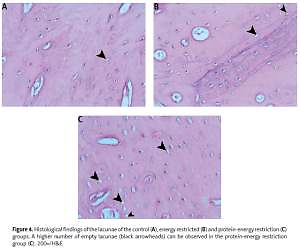Current issue
Archive
Manuscripts accepted
About the Journal
Editorial office
Editorial board
Section Editors
Abstracting and indexing
Subscription
Contact
Ethical standards and procedures
Most read articles
Instructions for authors
Article Processing Charge (APC)
Regulations of paying article processing charge (APC)
RHEUMATOLOGY / EXPERIMENTAL RESEARCH
Maternal undernutrition during lactation leads to reduction in skull size and thickness of adult-aged Wistar rats
1
Fluminense Federal University, Niterói, Rio de Janeiro, Brazil
2
Medical Sciences Post Graduation Program, Fluminense Federal University, Niterói, Rio de Janeiro, Brazil
Submission date: 2018-03-09
Final revision date: 2018-06-25
Acceptance date: 2018-07-05
Online publication date: 2020-01-19
Publication date: 2021-07-16
Arch Med Sci 2021;17(4):1093-1099
KEYWORDS
TOPICS
ABSTRACT
Introduction:
It is known that the quality and quantity of milk is directly related to the dietary habits of the mother. Despite that, the rates of maternal malnutrition during lactation are increasing in several countries; thus, observing its effects on the offspring is relevant. The present study aims to verify the effects of maternal malnutrition during breastfeeding on the skulls of adult-aged Wistar rats.
Material and methods:
Thirty-six newborn rats were divided in three groups: the control group, in which the mother received a regular commercial diet containing 23% protein in unlimited amounts; the protein-energy restriction group, in which the dam received a commercial diet containing 8% protein in unlimited amounts; the energy restricted group, in which the dam received a commercial diet containing 23% of protein in limited amounts. After weaning, all rats received the same diet as the control group until 180 days of age. Then, the rats were euthanized, and their crania were excised and measured in radiographic images. Afterwards, their skull was decalcified with nitric acid (5%) and histological samples were obtained and the thickness of the diploe was verified. Descriptive statistics and ANOVA followed by the Newman-Keuls test were performed for comparison purposes.
Results:
It was observed that the skull from the protein-energy restriction and energy-restriction groups was smaller and thinner than that of the control group in several parameters.
Conclusions:
Maternal malnutrition during the lactation period caused long-term effects in skull morphology of Wistar rats. These effects could not be reversed after regulation of the diet.
It is known that the quality and quantity of milk is directly related to the dietary habits of the mother. Despite that, the rates of maternal malnutrition during lactation are increasing in several countries; thus, observing its effects on the offspring is relevant. The present study aims to verify the effects of maternal malnutrition during breastfeeding on the skulls of adult-aged Wistar rats.
Material and methods:
Thirty-six newborn rats were divided in three groups: the control group, in which the mother received a regular commercial diet containing 23% protein in unlimited amounts; the protein-energy restriction group, in which the dam received a commercial diet containing 8% protein in unlimited amounts; the energy restricted group, in which the dam received a commercial diet containing 23% of protein in limited amounts. After weaning, all rats received the same diet as the control group until 180 days of age. Then, the rats were euthanized, and their crania were excised and measured in radiographic images. Afterwards, their skull was decalcified with nitric acid (5%) and histological samples were obtained and the thickness of the diploe was verified. Descriptive statistics and ANOVA followed by the Newman-Keuls test were performed for comparison purposes.
Results:
It was observed that the skull from the protein-energy restriction and energy-restriction groups was smaller and thinner than that of the control group in several parameters.
Conclusions:
Maternal malnutrition during the lactation period caused long-term effects in skull morphology of Wistar rats. These effects could not be reversed after regulation of the diet.
We process personal data collected when visiting the website. The function of obtaining information about users and their behavior is carried out by voluntarily entered information in forms and saving cookies in end devices. Data, including cookies, are used to provide services, improve the user experience and to analyze the traffic in accordance with the Privacy policy. Data are also collected and processed by Google Analytics tool (more).
You can change cookies settings in your browser. Restricted use of cookies in the browser configuration may affect some functionalities of the website.
You can change cookies settings in your browser. Restricted use of cookies in the browser configuration may affect some functionalities of the website.



